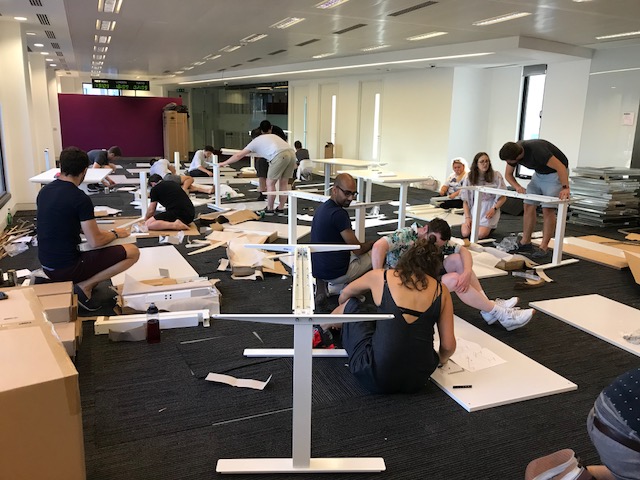In May 2017 we moved into an office near Old Street, London. We were 80 people strong and really looking forward to the next three years in our spacious 13,000 sq ft home. Things didn’t go to plan, but luckily in a good way!
Our rapidly expanding team has meant that we just had to move again, this time into a shiny new 48,000 sq ft office in Finsbury Square. And boy have we learnt a lot about the dos and don’ts of office moves, mostly by finding out the hard way!
Like any startup that’s scaled quickly, we were complete novices when it came to facilities management and large scale moves. So we wanted to share some of the things we’ve learned that might help other fast growing startups with their next move.
Start planning earlier than you think
We’ve been surprised by how long the move has taken. We began planning in December 2017 by which time we had 149 Monzonauts based in London. Since we started the team in London’s grown to 236!
Make sure you’re continually on the pulse with your hiring plan, you don’t want to have to split employees across temporary sites while you plan the move.
Set clear expectations with your third party experts to make sure they move as quick as you need them to. We were constantly reminded about how quickly tech startups can/need to operate compared to other firms.
Find out whether you need a Licence to Alter. This is a legal licence that allows you to carry out your fit out works, and depending on the size of the building, you may need to submit one. Before signing your Lease, make sure you know whether you’ll need a Licence to Alter, who needs to approve it, how much detail needs to be submitted, what kind of work should be detailed and how long it will take to process.
Be completely transparent every step of the way
Moving offices can cause people a lot of anxiety. Let’s be honest, no one likes change! So you should over-communicate everything. Everyone’s different and some people become very attached to their space. At Monzo wellbeing and mental health is a top priority.
At Monzo we default to transparency meaning that we look for reasons not to share information, both internally and externally. So we shared detailed updates with everyone during the move. We used three kinds of update:
For those who love the detail, we wrote out over 170 tasks which needed to be completed. We also had a public Slack channel to discuss everything move related
For those who wanted to see weekly progress, we had readily available weekly catch up minutes and a ‘Technical phrase of the week’ so all Monzonauts could share in the learning especially around property law and facilities management
For those who just wanted high level updates, we made several announcements at the company wide ‘All-Hands’ meeting (making sure we shared messages that were sometimes not positive, for example time delays)
Drop the jargon. Your external experts such as lawyers and contractors use their own terms, from Risk Assessment Method Statements to Joint Contractual Tribunals. Make sure you write updates in plain English so that everyone can relate to it.
The seating plan can cause anxiety so spend a lot of time and energy on it to make sure people feel listened to and will be productive in their new home. This is an iterative process so take the time to listen to everyone, ask for frequent feedback and make sure you think about future team growth.
Involve as many people as possible, whether it’s organising an IKEA furniture-building social to getting the team to decorate meeting rooms. Being a startup moving into a shiny new building, we found it super important to stress the ‘we haven’t made it’ message throughout the process.

Moving into a bigger building can be a completely different ball game
A bigger building means more responsibility, more legal agreements and consequently more cost in places you never knew existed!
Hire a Facilities Manager earlier rather than later, making sure they have technical engineering knowledge because you’ll be entering a new world of air handling units, ceiling voids and electrical risers.
Make sure you plan for additional costs, whether it’s variations on your fit out plans, additional legal fees or any surprise costs during the move!
If you can, do the furniture yourself or use a platform that cuts out the middle person. For example, a platform that connects you directly to furniture wholesalers such as Eporta has helped us keep the costs down, and places like IKEA have been perfect for everything else.
After an enormous effort from the team, we’ve successfully moved into our new office. It’ll take some time to make it feel like home, but we’re so happy to be under the same roof again. We’re always learning, but hope that these lessons and tips might help your startup when planning your next move!